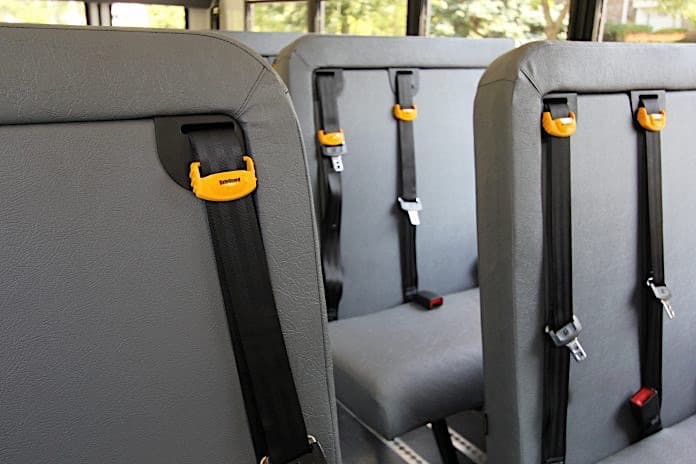A School Bus Safety Working Group called for by Ohio Gov. Mike DeWine following a fatal student ejection in August heard from several safety experts that seatbelts if installed could have changed the rollover crash outcome
Kristin Poland, deputy director of the Office of Highway Safety at the National Transportation Safety Board, kicked off the Sept. 25 meeting by discussing safety recommendations made following school bus crashes.
For instance, Poland compared school bus crashes in which lap/shoulder seatbelts were installed and crashes in which school buses didn’t have belts at all, finding that lap/shoulder seatbelts keep students in their seating position. Addressing a concern voiced by some group members about seatbelts constraining the child in the impact zone, Poland explained that students wearing lap/shoulder seatbelts are actually pushed away from crash forces. She added that when wearing laps/shoulder seatbelts, students remain compartmentalized with cushioned, high. They are not being thrown toward the point of impact. Without seatbelts, students are propelled out of compartmentalization.
She added that wearing the lap/shoulder belts results in children sitting properly and facing forward, which is when compartmentalization is most effective.
Other seatbelt-related questions centered on students being able to unbuckle themselves and evacuate the school bus in an emergency. Poland explained that when students are wearing lap/shoulder seatbelts, children are less likely to be injured, and they can unbuckle in an inverted position. Without seatbelts, there’s a greater risk of injury, she explained, especially head injuries that could cause students to become unconscious.
Federal Motor Vehicle Safety Standard 209 provides buckle release requirements, stating that seatbelts shall release when a force of not more than 30 pounds is applied. Plus,
The Iowa Pupil Transportation Association (IPTA) studied school bus evacuation times in July 2019 for children with a seatbelt and children without. It took a little over a minute for children to evacuate from the bus with no seatbelts and about 45 seconds to evacuate with seatbelts. While the results may seem illogical, IPTA concluded that seatbelts make little difference in student evacuation time.
A lap/shoulder seatbelt expert also spoke the the work group last month and brought a seat with flex seating lap/shoulder seatbelts for the Task Force to review. The flex seating showed that the seatbelts can be adjusted based on the size of the child, as this was another concern voiced by some committee members.
Sgt. Trevor Jasper of the Ohio Highway Patrol then discussed the school bus crash history in the state. He explained that of all school bus-related crashes nationwide in the last five years, 0.4 percent occurred in Ohio. He added that those six Ohio school bus crashes in resulted in 13 serious injuries.
Jasper recalled a 2019 school bus crash that he responded to. Five students suffered serious injuries. He said a vehicle that ran a red light struck the front driver’s side of the school bus. The bus driver lost control, and the bus overturned, rotated into a guard rail, and came to rest facing northbound on its right side. No student seatbelts were installed, and no students were ejected. However, Jasper did not disclose the nature of the “serious injuries.”
Related: Ohio PTA Shows Support for Seatbelts in School Buses
Related: IMMI School Bus Crash Test Rounds Out STN EXPO Indy
Related: Don’t Forget About Seatbelts Amid COVID-19, STN EXPO Indy Panel Reminds
Related: NASDPTS Issues New Guidance Advocating Lap/Shoulder Seatbelts on School Buses
Related: Watch: Ohio School Bus Rollover Video Reignites Latest Seatbelt Debate
Researchers at the Ohio State University Biomechanics Research Center also presented school bus crash data from the National Highway Traffic Safety Administration. They explained that ejected occupants are more likely to be killed, and lap/shoulder seatbelts help to reduce ejections.
The researchers showed various videos of crash test “dummies” with lap/shoulder seatbelts and those without that were performed at the IMMI Center for Advance Product Evaluation facility. The videos indicate how students would react to similar crash forces. Working group members questioned why parents have not seen these videos, as they show the importance of students remaining seated and facing forward.
Doug Palmer, a transportation consultant with the Ohio School Boards Association, drove a school bus in the 1980s and discussed other modes of transportation such as walking, parent transport, and biking, to name a few. He noted that parent transport is increasing, and he asked the working group to consider the effect of increased traffic on pick-up and drop-off lines at schools. He asked if school buses could still drop off students promptly or if they become stuck in traffic.
Palmer suggested reviewing school sites to determine potential upgrades, such as staggered departure times for cars and buses or designated bus lanes.
The next meeting will take place on Oct. 12.














